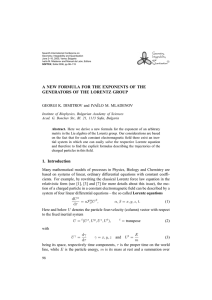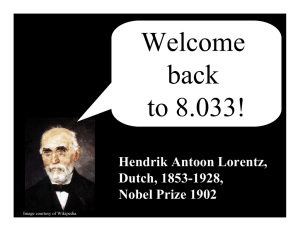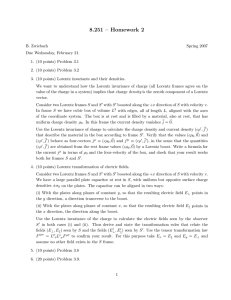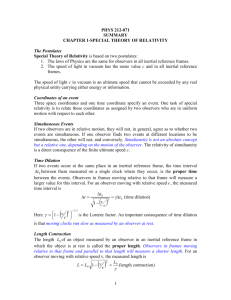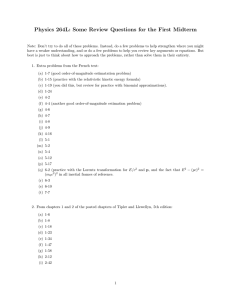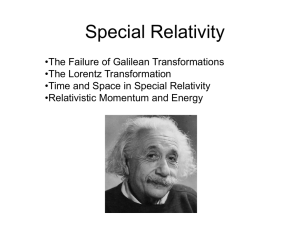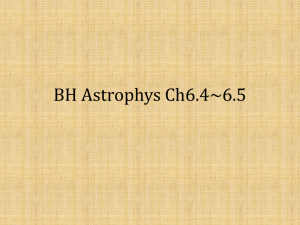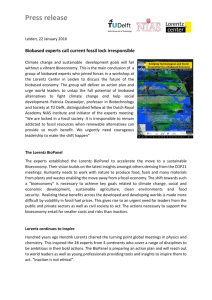lecture_2
advertisement
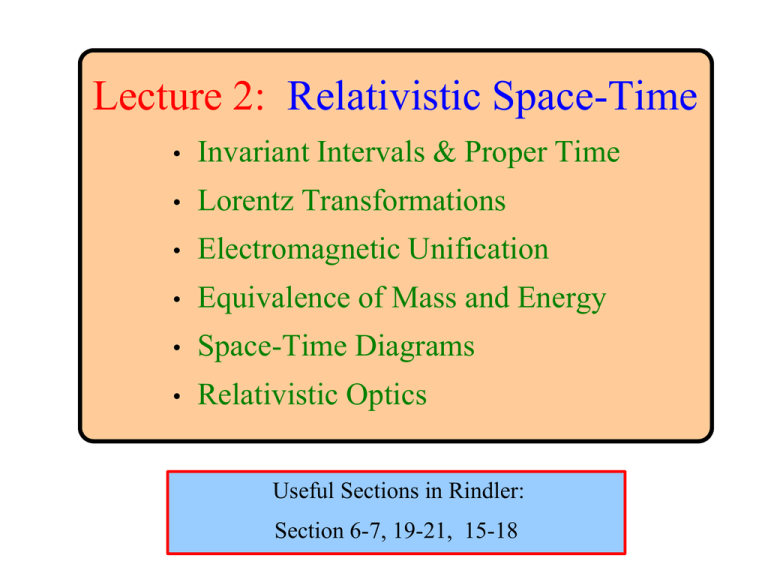
Lecture 2: Relativistic Space-Time
•
Invariant Intervals & Proper Time
•
Lorentz Transformations
•
Electromagnetic Unification
•
Equivalence of Mass and Energy
•
Space-Time Diagrams
•
Relativistic Optics
Useful Sections in Rindler:
Section 6-7, 19-21, 15-18
Einstein’s Two Postulates
of Special Relativity:
I. The laws of physics are identical
in all inertial frames
II. Light propagates in vacuum rectilinearly,
with the same speed at all times, in all
directions and in all inertial frames
Time Dilation:
d
t
d
c=
t
t
-v
v
v
v
v
v
d
x = vt
d2 +v2t 2 =(d/t )2+v2 =(c /t )2 + v2
t
c=
t
t =
t
1 - (v/c)2
Recall:
d2 +(x )2
c=
t
(c t )2 = d2 + (x )2
Thus,
d2 = (c t )2 - (x )2
invariant
choose frame
''at rest”
or, more generally,
S2
= (c t
)2
- [(x
)2+
(y
''Invariant Interval”
)2+
(z
)2 ]
= (c t)2
“Proper Time”
Lorentz Transformations:
Consider light beam moving along positive x-axis:
x = ct
x - ct = 0
or
Similarly, in the moving frame, we want to have
x = ct
x - ct = 0
or
x - ct = a(x - ct )
We can insure this is the case if:
Generally, the factor could be different
for motion in the opposite direction:
Subtracting
x + ct = b(x + ct )
t =
(a+ b)
2
t -
=
(a+ b)
2
[t -
= A
[t
-
(a-b)
2
x/c
(a-b)
x/c
(a+b)
]
Bx/c ]
t
= A
[t
t = A t
-
Bx/c ]
So, we know that A = g
(at fixed x)
Similarly,
x = g [ x - Bct ]
In non-relativistic limit (g 1) :
x [ x - Bct ]
Must correspond to Galilean transformation, so
Bc = v
B = v/c
x = g [ x - vt ]
t = g [ t - (v/c2)x ]
''Lorentz-Fitzgerald Contraction”
''Aether Drag”
George Francis Fitzgerald
Maxwell’s Equations
Hendrik Antoon Lorentz
Lab Frame
v
+q
- +
- +
- +
F
I
(pure magnetic)
B
- +
In Frame of
Test Charge
+q
F
(pure electrostatic)
-
+
+
+
+
- +
Lorentz Lorentz
expanded contracted
Symmetry:
The effect of a force
looks the same when
viewed from reference
frames boosted in the
perpendicular direction
Electricity & Magnetism
are identically the same
force, just viewed from
different reference frames
UNIFICATION !!
(thanks to Lorentz invariance)
Lab Frame
v
- +
+q
- +
- +
F
I
F = qv B
| F | = qv Imo/ (2pr)
B
llab+ = l
llab- = l
+
lq- = lg
lq = lg
+
l´ = lq+ - l- = l(g-1g) =lgb2
- +
(pure magnetic)
In Frame of
Test Charge
-
+q
+
E = l / 2preo = lgv2 / (2preoc2)
= lgv2 mo/ (2pr)
+
- +
F
Lorentz Lorentz
expanded contracted
(pure electrostatic)
| F ´| = Eq = lgv2 moq / (2pr)
lv = I
| F ´| = gIvmoq / (2pr)
| F | = | F ´| / g = qvImo / (2pr)
Einstein’s The 2 Postulates
of Special Relativity:
I. The laws of physics are identical
in all inertial frames
II. Light propagates in vacuum rectilinearly,
with the same speed at all times, in all
directions and in all inertial frames
Planck’s recommendation for Einstein’s nomination
to the Prussian Academy in 1913:
“In summary, one can say that there is hardly one among
the great problems in which modern physics is so rich to
which Einstein has not made a remarkable contribution.
That he may sometimes have missed the target in his
speculations, as, for example, in his hypothesis of light
quanta, cannot really be held against him, for it is not
possible to introduce really new ideas even in the most
exact sciences without sometimes taking a risk.”
1905
“Einstein’s Box”:
L
emitter
E/c = Mv
recoil
p=Mv
motion
stops
distance travelled
d = vt = v (L/c)
= EL/(Mc2)
But no external forces, so CM cannot change!
Must have done the equivalent of shifting
some mass m to other side, such that
Md = mL
p = h/l (De Broglie)
E = pc
p=E/c
absorber
E = hn (Planck)
= hc/l
M {EL/(Mc2)} = m L
Space-Time:
ct
+y
-x
+x
-y
ct
returns to point
of origin
ct2
slope = (ct2 - ct1)/(x2-x1)
= ct/x = c/v = 1/b
moves with constant
velocity (b) until t2
ct1
object stationary
until time t1
-x
x1
x2
+x
ct
tanq = x/ct = v/c = b
light sent
backwards
v=c
v=c
qmax = 45°
q
45°
-x
tanqmax = 1
45°
+x
ct
“absolute future”
“absolute elsewhere”
-x
no message sent from the
origin can be received by
observers at x1 until time t1
ct1
x1
“absolute past”
+x
there is no causal contact
until they are
“inside the light cone”
ct
“absolute future”
“absolute elsewhere”
-x
+x
“absolute past”
ct
q
-x
+x
ct
q
-x
+x
ct
q
-x
+x
ct
q
-x
+x
ct
q
-x
+x
ct
q
q
-x
+x
ct
q
q
-x
+x
S
ct
S´
q
q
-x
+x
Spacetime
Showdown
-x
ct
+x
Relativistic
Optics
v
t = g t
f = 1/t = 1/gt = f/ g
Transverse Doppler Reddening
a
a
a
a
a
v
a
v
a
a v/c
v
a1 - (v/c)2
a v/c
(a v/c)2 + (a1 - (v/c)2 )2
= a2
Terrell Rotation
(1959)
a1 - (v/c)2
v
a1 - (v/c)2
a v/c
(a v/c)2 + (a 1 - (v/c)2 )2
= a2
Penrose (1959):
A Sphere By Any
Other Frame Is
Just As Round
h
h
v
d
More generally, from somewhat off-axis hyperbolic curvature
h
h
v
d
SS 433
Jet orientation fixed by
relative Doppler shifts
History of jet precession
(period = 162 days)
vt
d
s
If assumed distance to object increases,
so must the distance traversed by jet to
preserve same angular scale for “peaks”
and, hence, jet velocity must increase.
q
Light observed from a given point
in the jet was produced t = (s-d)/c
earlier, thus distorting the apparent
orientation of the loops
Can fit distance to the source = 5.5 kpc (K. Blundell & M. Bowler)
Can even show evidence of jet speed variations!
Angular compression towards centre of field-of-view
Intensity =
light received
solid angle
increases towards centre
“Headlight Effect”
From “Visualizing Special Relativity”
www.anu.edu.au/Physics/Searle

